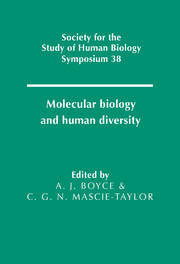Book contents
- Frontmatter
- Contents
- List of contributors
- Preface
- 1 Mitochondrial DNA in ancient and modern humans
- 2 Digital DNA typing of human paternal lineages
- 3 Minisatellites as tools for population genetic analysis
- 4 DNA fingerprinting: development of a technology and its application to the study of human populations
- 5 Kinship, inbreeding, and matching probabilities
- 6 Using the coalescent to interpret gene trees
- 7 Some attempts at measuring natural selection by malaria
- 8 AIDA: Geographical patterns of DNA diversity investigated by autocorrelation statistics
- 9 Mitochondrial DNA sequences in Europe: an insight into population history
- 10 Palaeolithic and neolithic contributions to the European mitochondrial gene pool
- 11 The molecular diversity of the Niokholo Mandenkalu from Eastern Senegal: an insight into West Africa genetic history
- 12 The peopling of Madagascar
- 13 Molecular perspectives on the colonisation of the Pacific
- 14 Population ancestry on Tristan da Cunha–the evidence of the individual
- 15 Linguistic divergence and genetic evolution: a molecular perspective from the New World
- 16 Allelic sequence diversity at the human β-globin locus
- 17 A nuclear perspective on human evolution
- 18 Contrasting gene trees and population trees of the evolution of modern humans
- 19 Methods and models for understanding human diversity
- Index
6 - Using the coalescent to interpret gene trees
Published online by Cambridge University Press: 19 September 2009
- Frontmatter
- Contents
- List of contributors
- Preface
- 1 Mitochondrial DNA in ancient and modern humans
- 2 Digital DNA typing of human paternal lineages
- 3 Minisatellites as tools for population genetic analysis
- 4 DNA fingerprinting: development of a technology and its application to the study of human populations
- 5 Kinship, inbreeding, and matching probabilities
- 6 Using the coalescent to interpret gene trees
- 7 Some attempts at measuring natural selection by malaria
- 8 AIDA: Geographical patterns of DNA diversity investigated by autocorrelation statistics
- 9 Mitochondrial DNA sequences in Europe: an insight into population history
- 10 Palaeolithic and neolithic contributions to the European mitochondrial gene pool
- 11 The molecular diversity of the Niokholo Mandenkalu from Eastern Senegal: an insight into West Africa genetic history
- 12 The peopling of Madagascar
- 13 Molecular perspectives on the colonisation of the Pacific
- 14 Population ancestry on Tristan da Cunha–the evidence of the individual
- 15 Linguistic divergence and genetic evolution: a molecular perspective from the New World
- 16 Allelic sequence diversity at the human β-globin locus
- 17 A nuclear perspective on human evolution
- 18 Contrasting gene trees and population trees of the evolution of modern humans
- 19 Methods and models for understanding human diversity
- Index
Summary
Human genetic diversity: is it old?
In the last decade, molecular biology has provided sophisticated technology for assaying DNA polymorphisms, and considerable research effort has been devoted to characterizing human variability at the DNA level. Many geneticists are concentrating on the DNA variation that explains human diversity at the phenotypic level, with particular attention being given to genetic diseases. Most of the disease alleles so far identified have restricted geographic distributions, are relatively rare, and were probably generated by recent mutation events. Cystic fibrosis is an example of a genetic disease prevalent in Europe and estimated to have arisen perhaps 53000 years ago (Morral et al., 1993). A few disease alleles with similarly restricted geographical distributions, are much more common, clearly as the result of powerful selection. Such are the haemoglobinopathies which are subject to malarial selection. Allelic variants occur at both the α- and β-globin genes, causing α- and β-thalassaemias, sickle-cell anaemia and other traits and diseases. It is difficult to judge whether they arose very recently, possibly even within the last 10000 years, or are older, say 50 000–100 000 years (Flint et al., 1993). Studies of variation not accounting for obvious functional differences have been taken up by biological anthropologists.
- Type
- Chapter
- Information
- Molecular Biology and Human Diversity , pp. 63 - 80Publisher: Cambridge University PressPrint publication year: 1996



